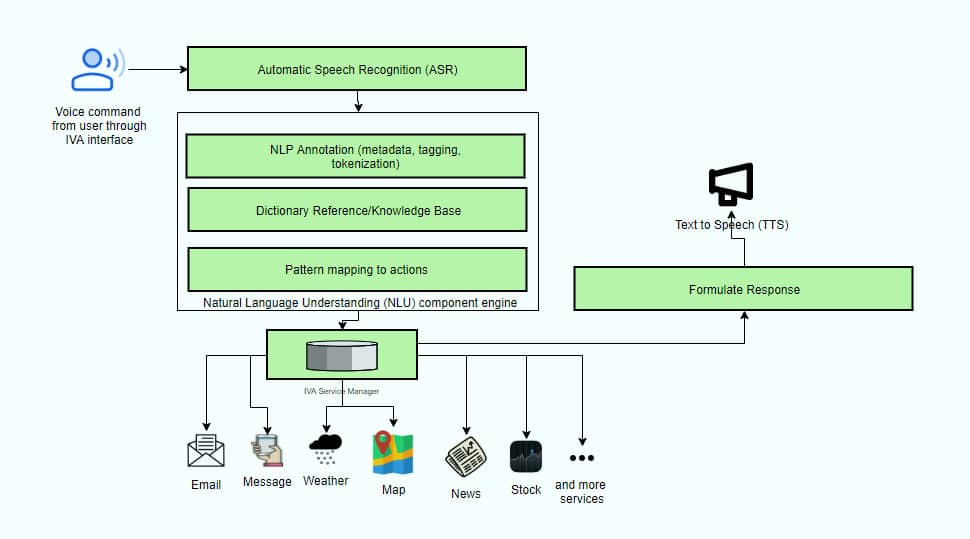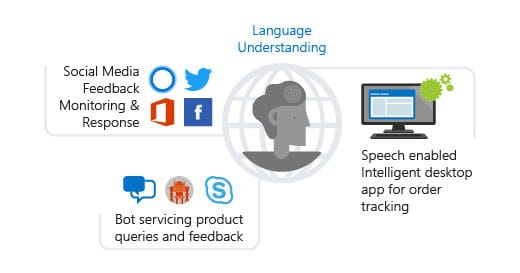Conversational AI helps customers interact with computer applications like chatbots just the way they would with humans. Let’s explore this domain and take a look at what the tech giants are offering in this space.
Conversational artificial intelligence (AI) is today being used to implement various new age AI solutions like chatbots, virtual assistants, and contact centres, to name a few. Cloud based architectures like Azure AI, AWS ML or GCP ML provide many services suitable for building a chatbot combined with other native cloud services. AWS has even provided pre-build CloudFormation templates from Marketplace to swiftly develop a serverless chatbot service.
Smart devices like Amazon Echo and Apple HomePod use voice based intelligent virtual assistants (IVAs) to automate regular tasks. Amazon Echo uses Alexa, while Apple HomePod uses Siri. These simple software agents can take voice commands and execute tasks using an Internet connection and API interfaces.
Technical architecture of conversational AI chatbots
Typically, all IVA interfaces work using natural language processing (NLP) by segmenting audio inputs. For example, a command like “Siri, call Alan on his home number,” will be split into each word using automatic speech recognition (ASR). The dictionary of phonetics will then be searched for a suitable mapped pattern to get the relevant action to execute the command by using an API interface. After executing the action, the response will be formulated using a text-to-speech (TTS) interface.

A chatbot is an IVA but is different from Siri/Alexa devices. A chatbot or conversational assistant is a dialogue based system that takes continuous inputs and uses previous chat messages to contextualise the response. Alexa/Siri are service agents that take commands and have an event driven approach, where a voice command is the event.
Chatbots vs conversational AI
Telemedicine and virtual health consultation are the new normal in the world after the recent pandemic. Hence, small clinics to large medical institutions prefer to develop and deploy a health bot, which can help patients with remote consultation. Health bots typically use AI and ML to process the query written by users through NLP, search for the response from their knowledge base, and have an interactive discussion with them. Hence, they are termed conversational AI enabled health bot solutions.
Chatbots and contact center AI play a critical role in developing a better customer experience. Traditionally, conversational AI was built by training the system to build the knowledge base and worked with a concrete set of functionalities only. With modern AI/ML services, self-managed conversational AI applications can be built very easily.
Azure Bot Service offers an AI agent that interacts with humans for support activities such as virtual banking assistance, insurance advice, IT helpdesk support and medical consultation, to name a few. The conversational AI solutions it offers are built on the following technical components.
Bot logic, which includes language understanding (LUIS) for predicting user intent from conversational natural language, QnA Maker to prepare questions and answers for FAQs and quick help, and Conversation Learner to automatically build the knowledge base, based on example interactions.
Speech capture converts speech to text using specific vocabulary and by understanding various styles of speech. Machine translation is used to translate text from different languages supported by the bot service.
Speech synthesis prepares the response from the knowledge base and pre-built answers, and uses a text to speech service to speak out responses from pre-built voices or create a custom voice. It helps users feel they are interacting with human assistants.
Some common use cases in conversational AI
Conversational AI is one of the most promising sectors of AI, with the global market for it projected to grow from US$ 4.2 billion in 2019 to US$ 15.7 billion by 2024. It is being used in both the commercial and domestic sectors today.
Here are a few use cases that highlight the revolution that conversational AI truly is.
Customer service: Conversational AI delivers the most impactful customer support services. It is now not only concerned with helping customers find timely solutions but is also making the life of agents better. Here are some examples.
- Better agent experience: AI helps agents do their jobs better; with the help of conversational AI, support executives can get through tickets much faster and have high quality interactions with customers.
- More self-service: By using a tool that can better leverage the knowledge base and company data, organisations can help customers
- help themselves better than ever before. AI can help answer the most frequently asked questions, giving customers what they need and deflecting redundant tasks from support agents.
- Improved support metrics: Increased rates of self-service and ticket deflection mean one thing: an improvement in the support team’s goals and metrics. Conversational AI is what a support team needs to help increase customer satisfaction by reducing response times.
- Automated purchasing: Conversational AI can help customers automatically make purchases online, set up automated repeat orders, and deal with any issues regarding their purchases.
- Insightful data: AI isn’t just helpful for the people using it; it can actually give very insightful data for businesses as a whole. By taking in data every single day, AI can help you learn about customer buying habits, get feedback, and help you strategise.
- Boost customer satisfaction metrics like NPS and CSAT: The best customer insights come after their interactions. With AI you can access data, analyse it using customer metrics and use it to improve business operations across the board.
Banking and financial services: Conversational AI is being used to reduce friction and make banking easy for customers to manage on their own. Besides automating functions and conversations, AI has helped reduce operating costs.
- Account management: Conversational AI or a banking virtual assistant can check customer balances and process transactions across all bank accounts, help make transfers, freeze accounts, or increase limits with the help of artificial intelligence.
- Analysis of data: Businesses can learn a lot from customers’ banking habits, using the information to push initiatives and create goals that will improve customer experience.
Education: Education is one of the top industries benefiting from automated interactions and artificial intelligence. With Covid-19 moving learning online and institutions going through digital transformations to keep up with the times, it’s clear that there is an opportunity to change things within education and leverage AI.
Conversational AI has shown that the education industry is on track to make learning more personalised, accessible, feasible, streamlined, and instant. This is what AI is doing for education.
- Artificial teaching assistants: AI can help with personalised learning by providing individual artificial teaching assistants that learn about the student and can adapt to their study habits with them.
- Boost performance: AI can help figure out where students can perform better.
- Set learning pace: Everyone learns at their own pace. If students are following an online learning course, AI can help set the pace for their personalised learning.
Retail: According to a recent IBM study,the adoption of AI in retail and consumer products is expected to grow another 40 per cent in the next three years.
Here are a few examples of conversational AI implementation in retail.
- Searches: AI can help you get the most up-to-date information regarding prices and deals. Machine learning algorithms now show you personalised information based on past retail searches.
- Order management: Intelligent chatbots have come a long way. They can now be used to manage shopping orders, tracking order status with a bot that can automatically find the information you need.
- Account management: Chatbots can also help with account management. There’s no need for human interference when AI can reset passwords and set up two-factor authentication for customers.
Insurance: Insurance is finally undergoing a digital transformation and it’s using AI to help it. Here are a few examples.
- Assessing risk: With the emergence of machine learning algorithms, it’s become even easier for underwriters and insurance agents to bring in more information and data in order to gauge the risk being taken by insurance companies.
- Fraud detection:Insurance is complicated; it is not uncommon for people to lie on insurance applications to try to get better premiums or better coverage. AI can help detect fraud by having accuracy parameters set on applications in order to ensure that information being sent in is accurate and truthful.
- Reducing human error: The chain between a person and their insurance policy is wide and complex; there is a series of middlemen who examine information between the insured and the carrier. A lot of information can get lost due to human error and manual work. Conversational AI can reduce human error by analysing documents and data for you, minimising the friction and possibility for mistakes.
Travel: With conversational AI, the travel industry has reached new heights.
- Booking: AI can help travellers book their flights! Chatbots can be deployed to help travellers find the best deals and secure them.
- Skychannel bots: If a friend or loved one is travelling, you can scan the sky for their flight using AI tools that tell you exactly where the flight is currently.
Now let’s briefly explore the conversational AI services being offered by the tech giants.
Azure Bot Service
Azure Language Understanding (LUIS) is a cloud API service from Microsoft, which uses custom ML services for conversational AI solutions like chatbot development. It uses an NLP technique called natural language understanding (NLU).

LUIS has three components – utterances, intent and entities. Utterances are plain text sentences which are thrown by users as a question to the bot. For example, “What time is the movie being shown in Casino?” Intents are the specific actions represented in the utterances. For example, ‘show time’ is the intent in the above example. Entity is the reference used in the utterance. ‘Casino theatre’ is the entity in this example.
LUIS can also be used for filtering negative or positive intents from social media posts. When there is a user input as a sentence, LUIS takes the utterances and does NLU processing. It gets the intent score as a value between 0 and 1. Based on the best score fitment, it gets the entities associated and fetches the response for the same from the knowledge base.
LUIS can be used to create custom language processing capability for any local language by training the model to process new utterances of a custom language model. Also, there are built-in security features available to keep the LUIS API accessible in a secured way. LUIS can run on Azure cloud, on-premises or on the edge, as well as by installing LUIS in a Dockerized container.
Amazon Lex
Amazon Lex is a service for building conversational interfaces into any application, using voice and text. It provides the advanced deep learning functionalities of automatic speech recognition (ASR) for converting speech to text, and natural language understanding (NLU) to recognise the intent of the text, to help build applications with highly engaging user experiences and lifelike conversational interactions

Amazon Lex enables any developer to build conversational chatbots quickly. No deep learning expertise is necessary—to create a bot, you just specify the basic conversation flow in the Amazon Lex console. It manages the dialogue and dynamically adjusts the responses in the conversation. Using the console, you can build, test, and publish your text or voice chatbot. You can then add the conversational interfaces to bots on mobile devices, web applications, and chat platforms (for example, Facebook Messenger).
Amazon Lex provides pre-built integration with AWS Lambda, and you can easily integrate with many other services on the AWS platform, including Amazon Cognito, AWS Mobile Hub, Amazon CloudWatch, and Amazon DynamoDB. Integration with Lambda provides bots access to pre-built serverless enterprise connectors to link to data in SaaS applications, such as Salesforce, HubSpot, or Marketo.
The following are the benefits of Amazon Lex:
- Integrated role-based access control across all AWS services (IAM)
- Comprehensive, cross-service API audit logging and security (CloudTrail)
- Integration with other AWS services (24×7 support and consolidated billing)
- Training and architectural patterns/guidance (well architected)
- A fully managed service, Amazon Lex scales automatically
- Easy-to-use console to guide you through the process
- Built-in integration with the AWS platform
- Amazon Lex bot processes voice or text input in conversation
- Helps build a complete natural language model
Google Contact Center AI
Google Cloud provides loads of AI based solutions, which are integrated with Google Contact Center AI services for virtual assistance.
A few important components that strengthen the capabilities of Contact Center AI (CCAI) of Google Cloud, and are in general availability mode (GA) now, are listed below.

Dialogflow CX: During customer assistance calls, complex queries need to be handled. Supplemental questions need a quick search of the knowledge base to quickly help human agents frame an appropriate reply. Dialogflow CX agents build on Google’s NLU algorithms to handle these search capabilities.
Agent Assist: This is built with AI assisted conversational services to prepare recommended answer choices for human agents to choose from when replying to customer queries. It uses a centralised knowledge base to prepare ready-to-use responses and also transcribe live calls in different languages. This aids AI enabled processing in the backend for training AI models to analyse frequently asked questions, answer patterns and customer groups based on interest.
CCAI Insights: From voice enabled calls to chat based text analysis, CCAI Insights helps to prepare metrics analysis, sentiment analysis and ratings to answers using the NLP capabilities of Google Cloud. This helps to analyse customer interactions and improve customer connects (chat/voice).
Google CCAI services include text to speech and speech to text conversion, sentiment analysis, ranking of responses, integrated IVR services and NLP to provide unified customer support powered by Google Cloud AI services.
IBM Watson
IBM Watson is a data analytics processor that uses NLP. It performs analytics on the vast repositories of data that it processes to answer human-posed questions, often in a fraction of a second.
IBM Watson’s cognitive and analytical capabilities enable it to respond to human speech, process vast stores of data, and return answers to questions that companies could never solve before.
The advantages of IBM Watson AI are:
- It gives you complete control of what is important to you and therefore the foundation of your competitive advantage, your data, models, learning, and API.
- Watson learns more from less because of its high learning power.
- It was initially available only on IBM Cloud but is now portable across any cloud-powered business. This prevents customers from being locked into one vendor and enables them to start deploying AI wherever their data resides.
- With new AI solutions like Meta’s BlenderBot and Microsoft Cortana, conversational AI has moved up to the next level in new age solutions across different sectors.
















































































